parking brake BUICK REGAL 1993 Owners Manual
[x] Cancel search | Manufacturer: BUICK, Model Year: 1993, Model line: REGAL, Model: BUICK REGAL 1993Pages: 308, PDF Size: 16.35 MB
Page 67 of 308
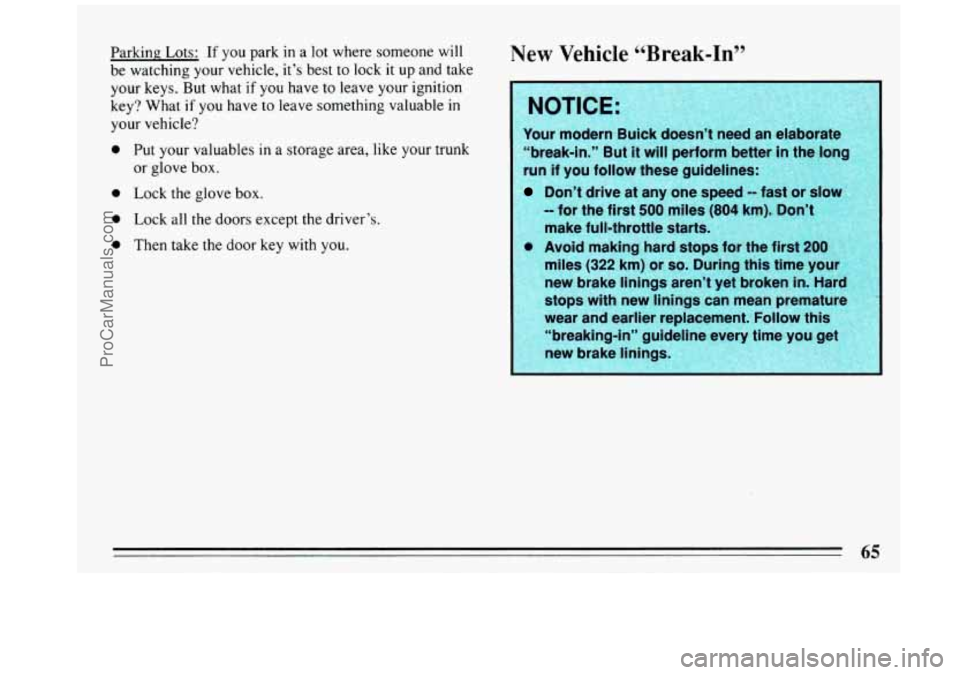
Parking Lots: If you park in a lot where someone will
be watching your vehicle, it’s best
to lock it up and take
your keys. But what
if you have to leave your ignition
key? What if
you have to leave something valuable in
your vehicle?
0 Put your valuables in a storage area, like your trunk
or glove box.
0 Lock the glove box.
0 Lock all the doors except the driver’s.
0 Then take the door key with you.
New Vehicle ‘LBreak-In99
Your modern Buick doesn’t need an elaborate
“break-in.” But
it will perform better
run if you follow these guidelines:
Don’t drive at any one speed -- fast or sin
-- for the first 500 miles (804. km,)Jon’+ .,,, ii’ ’
make full-throttle starts.
Avoid making hard stops for the
first 200
miles (322 km) or so. During this time your
new brake linings aren’t yet broken
in. Hard
stops with new linings can mean premature
wear and earlier replacement.
Follow this
“breaking-in” guideline every time you get
lew brake linings.
.ti“”.: .-,i- t.,/ +
65
ProCarManuals.com
Page 73 of 308
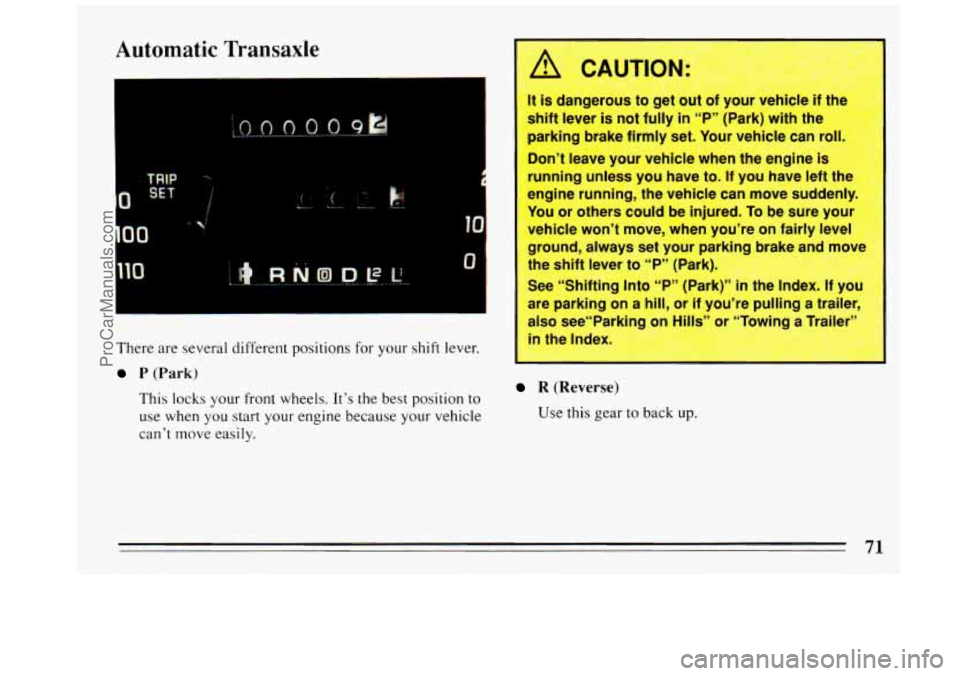
Automatic Transaxle
1
1%.
There are several different positions for your shift lever.
P (Park)
This locks your front wheels. It’s the best position to
use when you start your engine because your vehicle
can’t move easily.
A CAUTION:
It is dangerous to get out of your vehicle if the%
shift lever is not fully in “P” (Park) with the
parking brake firmly set. Your vehicle can roll.
Don’t leave your vehicle when the engine
is
running unless you have to. If you have left tht
engine running, the vehicle can move suddenly.
You or others could be injured. To be sure your
vehicle won’t move, when you’re on fairly level
ground, always set your parking brake and move
the shift lever to “P” (Park).
See “Shifting Into “P” (Park)”
in tl Index. I1 ;
are parking on a hill, or if you’re puliing a traller,
also see“Parking on Hills” or “Towing a Trailer”
R (Reverse)
Use this gear to back up.
71
ProCarManuals.com
Page 76 of 308
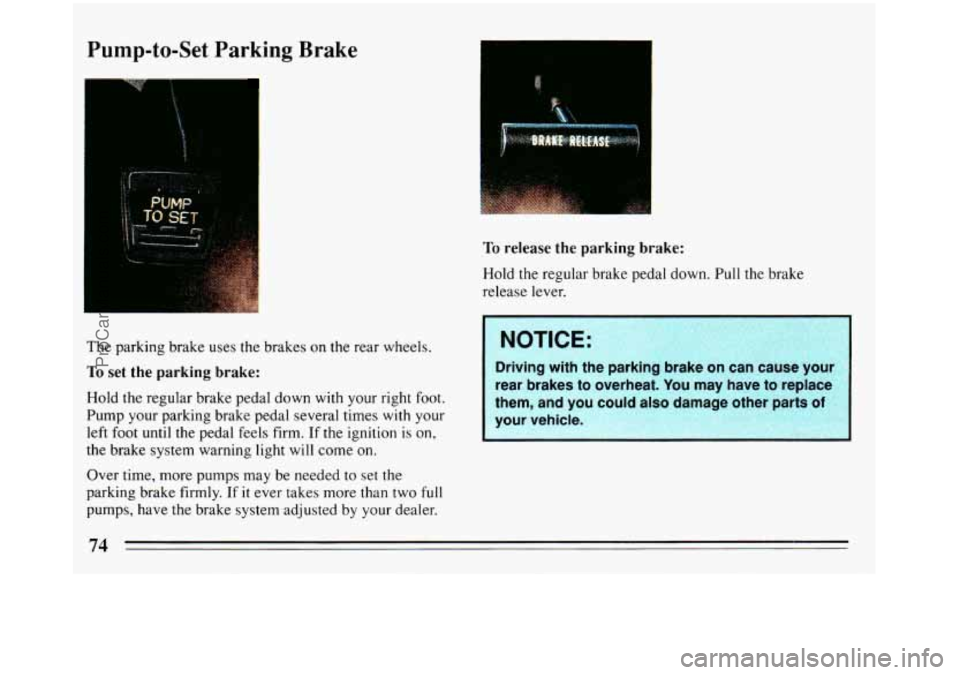
Pump-to-Set Parking Brake
The parking brake uses the brakes on the rear wheels.
To set the parking brake:
Hold the regular brake pedal down with your right foot.
Pump your parking brake pedal several times with your
left foot until the pedal feels firm. If the ignition is on,
the brake system warning light will come on.
Over time, more pumps may be needed to set the
parking brake firmly.
If it ever takes more than two full
pumps, have the brake system adjusted by your dealer.
To release the parking brake:
Hold the regular brake pedal down. Pull the brake
release lever.
.
NOTIC% I
Driving with the parking brake on can cause your
rear brakes to overheat. You may have to replace
your vehicle. them, and
you could also damage
74
ProCarManuals.com
Page 77 of 308
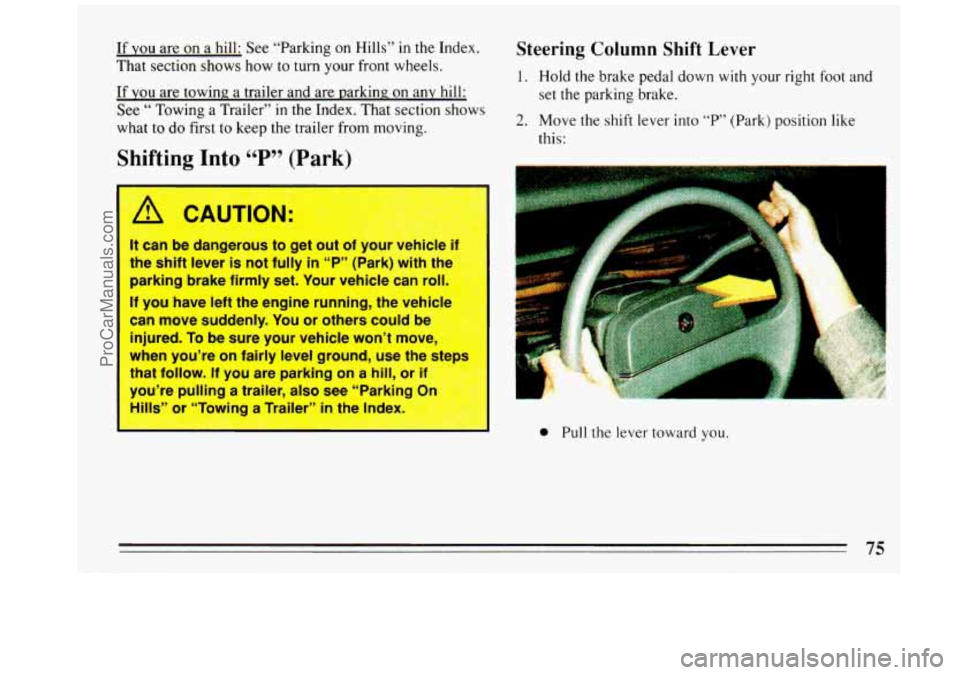
If YOU are on a hill: See “Parking on Hills” in the Index.
That section shows how to turn your front wheels.
If
you are towing. a trailer and are parking on any hill:
See
“ Towing a Trailer” in the Index. That section shows
what to do first to keep the trailer from moving.
Shifting Into 66 P 99 (P-k)
It can be dangerous to ger out of your vehicle if
the shift lever is not fully
in “P” (Park) with the
parking brake firmly set. Your vehicle can rol~
If you have left the engine running, the vehicl
can move suddenly. You or others could be
injured.
To be sure your vehicle won’t move,
when you’re on fairly level ground, use the
steps
that follow. If you are parking on a hill, or if
you’re pulling a trailer, also see “Parkinc 3n
Hills” 2r “Towing a Traile-” ’- the lrT’?x.
Steering Column Shift Lever
1. Hold the brake pedal down with your right foot and
set the parking brake.
2. Move the shift lever into “P77 (Park) position like
this:
0 Pull the lever toward you.
75
ProCarManuals.com
Page 78 of 308
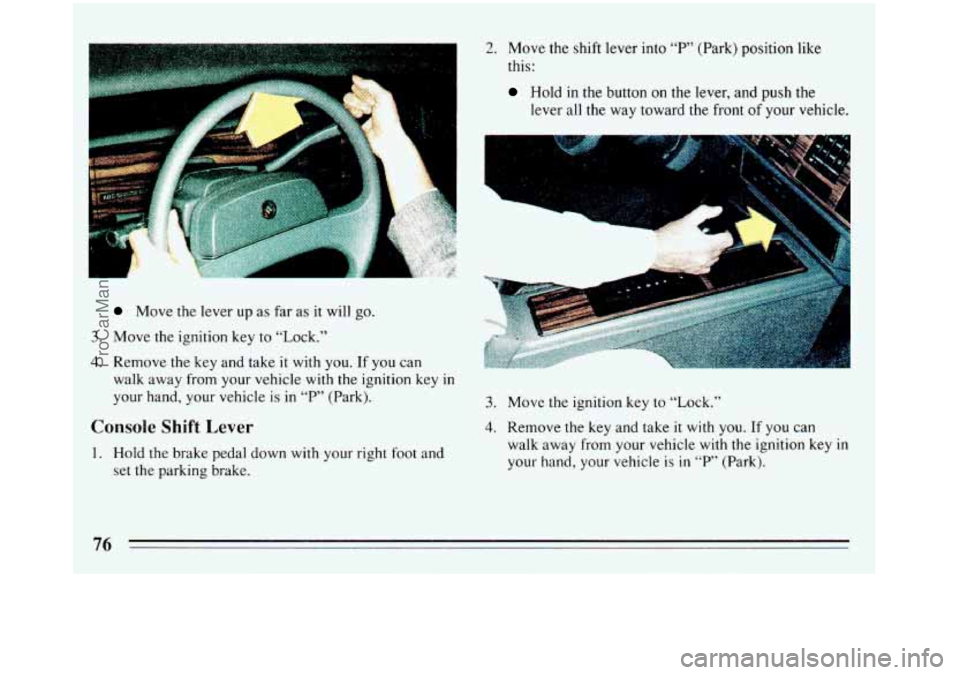
Move the lever up as far as it will go.
3. Move the ignition key to “Lock.”
4. Remove the key and take it with you. If you can
walk away from your vehicle with the ignition key in
your hand, your vehicle is in “P” (Park).
Console Shift Lever
1. Hold the brake pedal down with your right foot and
set the parking brake.
2. Move the shift lever into “P’ (Park) position like
this:
Hold in the button on the lever, and push the
lever all the way toward the front
of your vehicle.
-II
3. Move the ignition key to “Lock.”
4. Remove the key and take it with you. If you can
walk away from your vehicle with the ignition key
in
your hand, your vehicle is in “P’ (Park).
76
ProCarManuals.com
Page 81 of 308
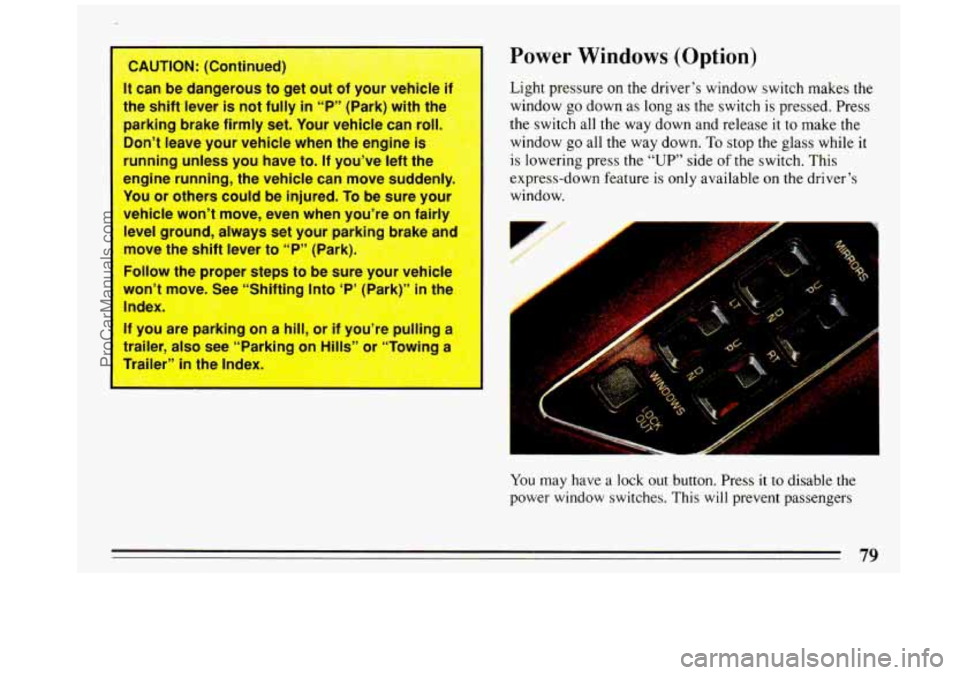
f
-
CAUTION: (Continued)
It can be dangerous to get out of your vehicle if
the shift lever
is not fully in “P” (Park) with the
parking brake firmly set. Your vehicle can roll.
Don’t leave your vehicle when the engine is
running unless you have to. If you’ve left the
engine
running, the vehicle can move suddenly.
You or others could be injured. To be sure your
vehicle won’t move, even when you’re
on fairly
level ground, always set your parking brake and
-we the shift lever to “P” (Park)
Follow the proper steps to be sure your vehicle
won’t move. See “Shifting Into ‘P’ (Park)”
in the
Index,
If you are parking on a hill, or if you’re pulling a
iler, also see “Parking on Hills” or “Towing a
ailer”
in the Index.
Power Windows (Option)
Light pressure on the driver’s window switch makes the
window go down as long as the switch is pressed. Press
the switch all the way down and release
it to make the
window go all the way down. To stop the glass while
it
is lowering press the “UP” side of the switch. This
express-down feature is only available
on the driver’s
window.
You may nave a lock out button. Press it to disable the
power window switches. This will prevent passengers
79
-
ProCarManuals.com
Page 93 of 308
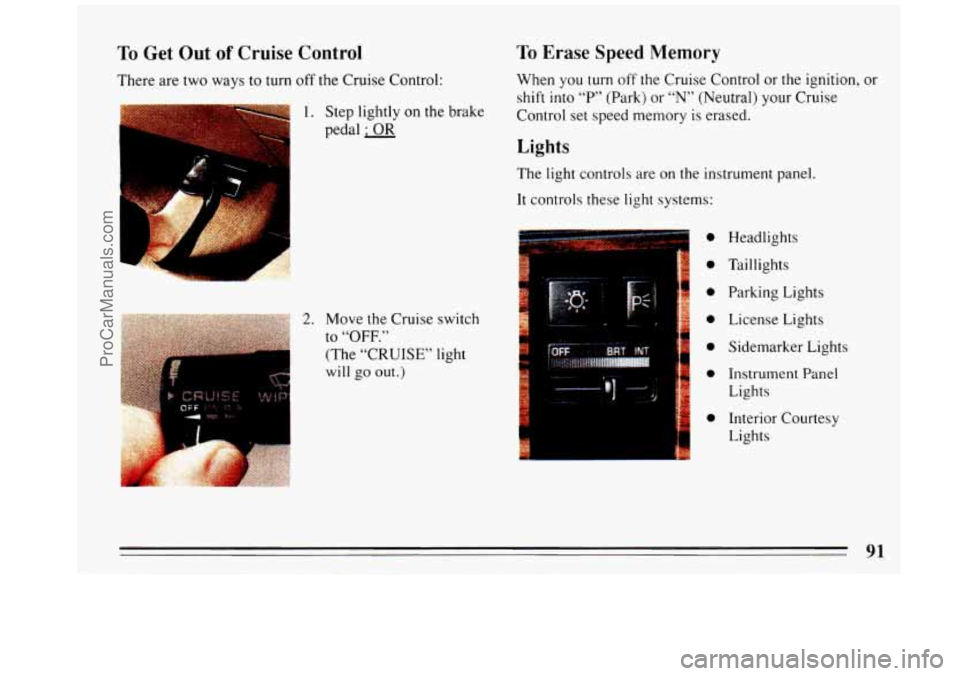
To Get Out of Cruise Control To Erase Speed Memory
When you turn off the Cruise Control or the ignition, or
shift into “P” (Park)
or “N” (Neutral) your Cruise
Control set speed memory
is erased.
Lights
The light controls are on the instrument panel.
It controls these light systems:
There are two
ways to turn
off the Cruise Control:
1. Step lightly on the brake
pedal
; OR
Headlights
Taillights
Parking Lights License Lights
Sidemarker Lights
Instrument Panel
Lights
Interior Courtesy
Lights 0
;o
:o
io 2. Move the Cruise switch
to “OFF.” 10 I (The “CRUISE” light
will go out.)
io
i
91
ProCarManuals.com
Page 94 of 308
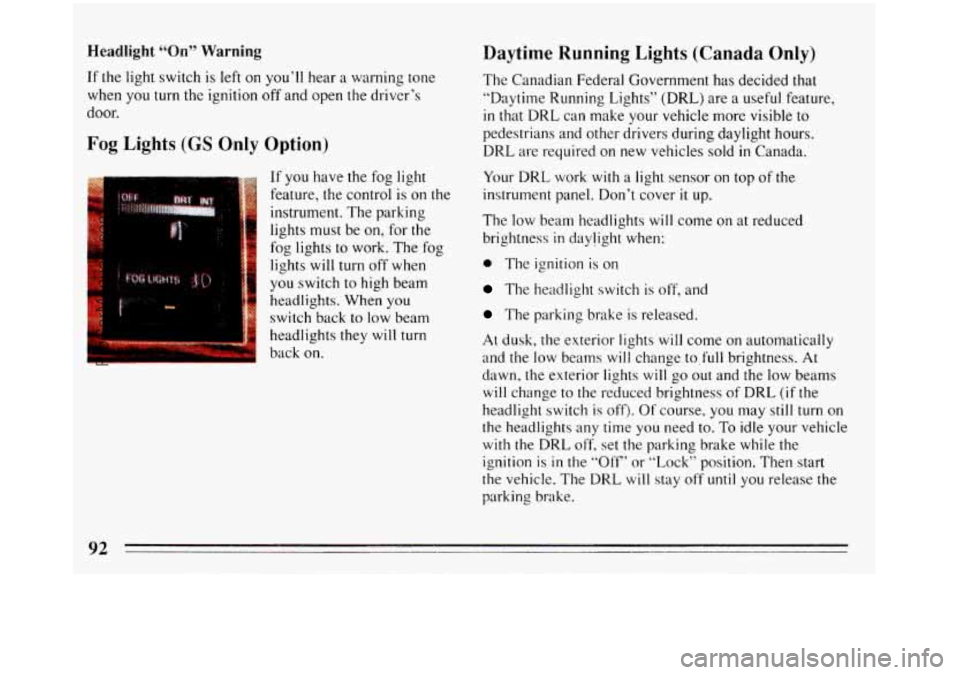
Headlight “On” Warning
If the light switch is left on you’ll hear a warning tone
when you turn the ignition
off and open the driver’s
door.
Fog Eights (GS Only Option)
If you have the fog light
feature, the control is on the
instrument. The parking
lights must be on, for the
fog lights to work. The fog
lights will turn off
when
you switch to high beam
headlights. When you
switch back to
low beam
headlights they
will turn
back on.
Daytime Running Lights (Canada Only)
The Canadian Federal Government has decided that
“Daytime Running Lights”
(DRL) are a useful feature,
in that DRL can make your vehicle more visible to
pedestrians and other drivers during daylight hours.
DRL are required on new vehicles sold
in Canada.
Your DRL work
with a light sensor on top of the
instrument panel. Don’t cover
it up.
The low beam headlights will come on at reduced
brightness
in daylight when:
0 The ignition is on
The headlight switch is off, and
The parking brake is released.
At dusk, the exterior lights will come on automatically
and the low beams will change to.full brightness.
At
dawn, the exterior lights will go out and the low beams
will change to the reduced brightness of DRL (if the
headlight switch
is off>. Of course, you may still turn on
the headlights any time you need to. To idle your vehicle
with the DRL off. set the parking brake while the
ignition
is in the “Off“ or “l,ock” position. Then start
the vehicle. The DRL
will stay off until you release the
parking brake.
92
ProCarManuals.com
Page 104 of 308
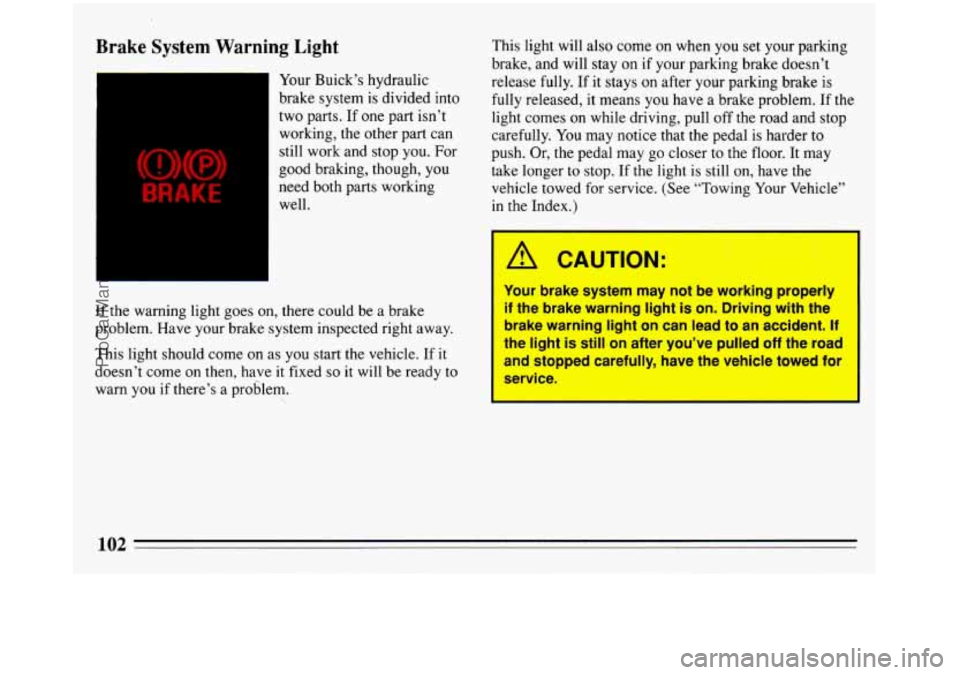
Brake System Warning Light
(a)(!)
BRAKE
Your Buick’s hydraulic
brake system is divided into
two parts. If one part isn’t
working, the other part can
still work and stop you. For
good braking, though, you
need both parts working well.
If the warning light goes on, there could be a brake
problem. Have your brake system inspected right away.
This light should come on as you start the vehicle.
If it
doesn’t come on then, have it fixed
so it will be ready to
warn you if there’s a problem. This
light will also come on when you set your parking
brake, and will stay on if your parking brake doesn’t
release fully. If it stays
on after your parking brake is
fully released, it means you have a brake problem. If the
light comes on while driving, pull off the road and stop
carefully. You may notice that the pedal is harder
to
push. Or, the pedal may go closer to the floor. It may
take longer to stop.
If the light is still on, have the
vehicle towed for service. (See “Towing Your Vehicle”
in the Index.)
A CAUTION:
Your brake system may not be working properly
if the brake warning light is on. Driving with the
brake warning light on can lead to an accident.
If
the light is still on after you’ve pulled off the road
and stopped carefully, have the vehicle towed fo
service.
aw,Tp 1 e- c -
102
ProCarManuals.com
Page 137 of 308
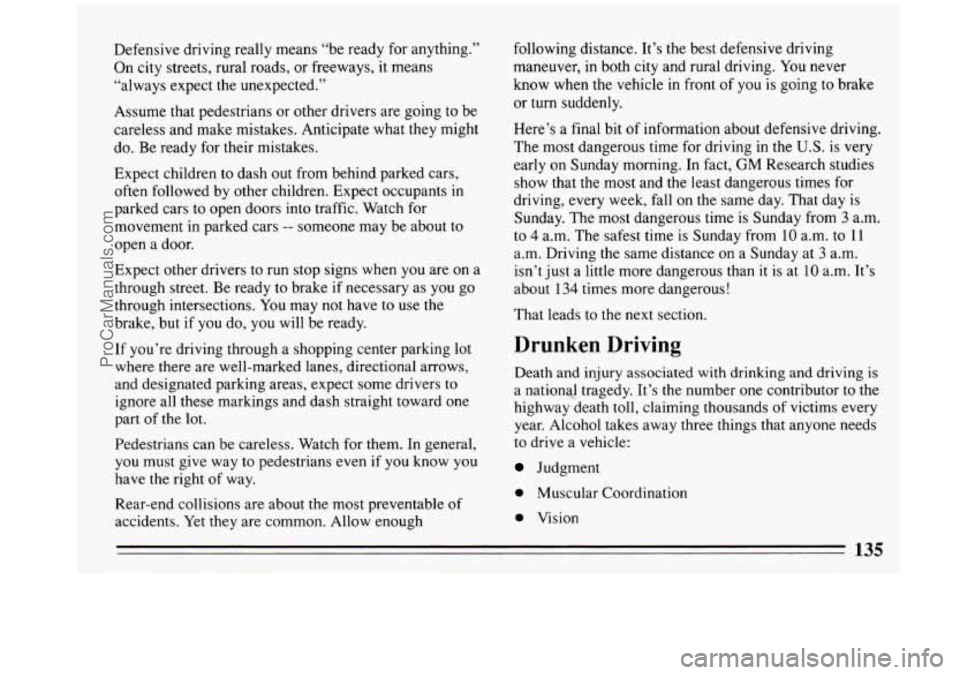
Defensive driving really means “be ready for anything.”
On city streets, rural roads, or freeways, it means
“always expect the unexpected.’’
Assume that pedestrians or other drivers are going to be
careless and make mistakes. Anticipate what they might
do. Be ready for their mistakes.
Expect children to dash out from behind.parked cars, often followed by other children. Expect occupants in
parked cars to open doors into traffic. Watch for
movement in parked cars
-- someone may be about to
open a door.
Expect other drivers to run stop signs when you are on a
through street. Be ready to brake if necessary as
you go
through intersections. You may not have to use the
brake, but if you do, you will be ready.
If you’re driving through a shopping center parking lot
where there are well-marked lanes, directional arrows,
and designated parking areas, expect some drivers
to
ignore all these markings and dash straight toward one
part
of the lot.
Pedestrians can be careless. Watch for them. In general,
you must give way to pedestrians even if
you know you
have the right of way.
Rear-end collisions are about
the most preventable of
accidents. Yet they are common. Allow enough following distance.
It’s the best defensive driving
maneuver, in both city and rural driving. You never
know when the vehicle in front of you is going to brake
or turn suddenly.
Here’s a final bit
of information about defensive driving.
The most dangerous time for driving in the
U.S. is very
early
on Sunday morning. In fact, GM Research studies
show that the most and the least dangerous times for
driving, every week, fall on the same day. That day is
Sunday. The most dangerous time is Sunday from
3 a.m.
to
4 a.m. The safest time is Sunday from 10 a.m. to 11
a.m. Driving the same distance
on a Sunday at 3 a.m.
isn’t just a little more dangerous than
it is at 10 a.m. It’s
about 134 times more dangerous!
That leads to the next section.
Drunken Driving
Death and injury associated with drinking and driving is
a national, tragedy. It’s the number one contributor
to the
highway death toll, claiming thousands of victims every
year. Alcohol takes away three things that anyone needs
to drive a vehicle:
Judgment
0 Muscular Coordination
0 Vision
135
ProCarManuals.com